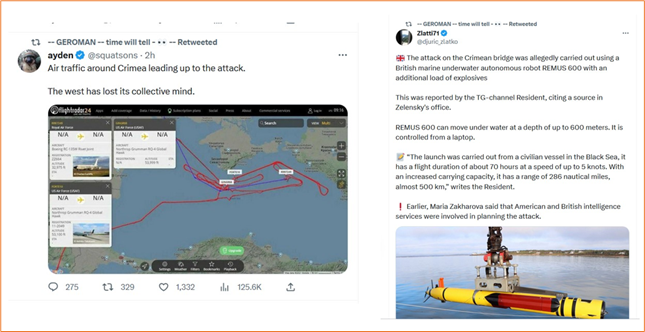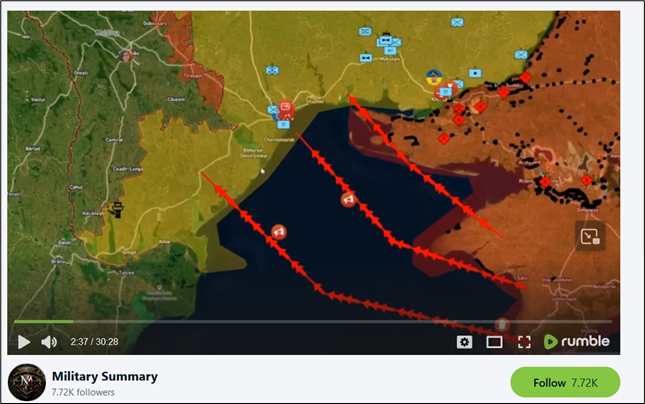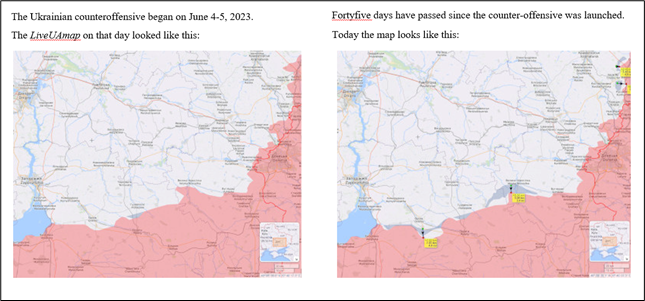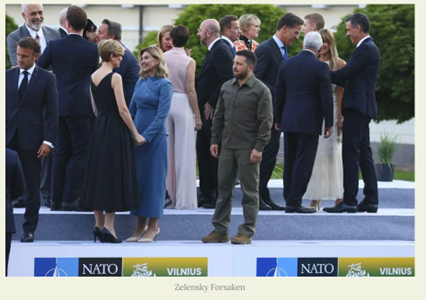Odessa – Crimea affair, July 2023
In the Big Picture, the war of attrition continues and the Ukrainian much-hyped counteroffensive is practically stalled with gigantic material and troops losses. Both sides make “optics strikes” in the rear areas but the fighting is going along the whole frontline, the fiercest battles in regions of Avdeevka, Artyomovsk/Bakhmut, Krasny Liman and Kupyansk.
Some examples of Ukrainian (AFU) losses: average rate of troops losses is continuously about 800- 1000 servicemen per day, which make a battalion per day; on July 22 was especially destructive regarding equipment: 36 IFV&APC from which 10 Bradleys, 7 Leopard tanks, 45 motor vehicles, 10 artillery pieces, 28 UAVs, one Su-25 aircraft shot down as well as several destroyed ammo and fuel depots and command posts.
Ukrainian attacks on Crimea and Crimea Bridge
The bombing attack on the Crimean bridge (Kerch bridge) on Monday July 17, was carried using naval drones by Ukrainian Navy and Secret Service with the support of the US and the UK. It killed two Russian civilians and wounded their child. Previously, Ukraine attacked the Crimean Bridge on October 8, 2022 halting all road and rail traffic.
From Russian viewpoint, the bridge represents a kind of “sacred” bond between Russia and Crimea and the time when Crimea left Ukraine and rejoined Russia. Further, in Russian view, the Kerch bridge attack is part of US-Ukraine “psyops” against Russian civilians living in Crimea. From Ukrainian viewpoint, the bridge is the symbol of Russian occupation.
The latest attempt by Ukraine to target objects in Crimea with drones came after Monday’s terrorist attack on the Crimean bridge. An attempt by the Kiev regime to carry out a terrorist attack using 28 unmanned aerial vehicles (UAV) was thwarted overnight, announced Russia’s Defense Ministry on Tuesday, July 18. Seventeen Ukrainian UAVs were destroyed by air defense systems, eleven more drones, suppressed by electronic warfare means, crashed without reaching their target. No casualties or damages resulted from the attack, added the MoD.
Moscow does not have any doubts that the terrorist attack on the Crimean Bridge was conducted by Ukraine, Kremlin spokesman Dmitry Peskov said on Tuesday. The road part of the bridge was damaged. Ukraine has admitted its complicity in both terrorist attacks on the Crimean Bridge. On Monday, Ukrainian media, citing a source in the Security Service of Ukraine, reported that the terror attack on the Crimean Bridge was conducted by the Security Service of Ukraine and the Ukrainian Navy, using surface drones.
NATO has built a large center by the American and the British specialists in Ochakovo (seaside town and port on the coast of Black Sea between Odessa and Nikolaev). They are training the special forces of Ukraine navy there and all sabotage attacks and maneuvers are coming from there. MI6 and CIA are working and organizing there. The Global Hawks and other US strategic drones, which capture and transmit information, are still constantly working in the Black Sea area.
Very soon after the strike, detailed information was emerging public: the attack was conducted by Ukraine’s Secret Service and Ukrainian Navy with the support of the US and the UK. The naval drones used in this strike were British-made underwater autonomous robots REMUS 600 and the whole operation was carried out under supervision of the American RQ-4 Global Hawk. No doubt, British MI6 and the American CIA were behind this operation. The practical proofs are convincing.

Grain deal
On July 17, the Black Sea Grain Deal (Russia, Ukraine, Turkey, the UN) expired and Russia decided not to extend it, given that the agreement was never implemented in its entirety by the collective West. According to Russian experts, the Kiev regime took advantage of the deal to transfer weapons and used the safe grain corridor for military purposes. Ukraine used civilian ships to transport weapons back and forth. Having frozen the Black Sea Grain Deal, Moscow highlighted that it is ready to resume it if the West implements its part of the agreement, with Ukraine ceasing its terrorist activities in the region.
Zelensky declared that “Ukraine intends to continue the implementation of the grain deal without Russia”. However, Kiev is uncapable to secure the navigation in the Black Sea by its own means. In its turn, Russia has withdrawn its guarantees of the safety of navigation in the north-western waters.
Part of the recent drone attacks was carried out from the zone where the grain corridor passed, that is, it was used as a cover. The ships that sailed there were also used as cover. Therefore, of course, it was initially clear that the enemy would use the grain corridor specifically for military purposes. Attacks on Sevastopol and other attacks originated from the grain corridor zone or passed through the green corridor zone, especially those attacks that came from Izmail or from the Odessa region.
The grain deal was brokered by the United Nations and Turkiye between Russia and Ukraine in July 2022 to facilitate the export of grain and fertilizer from Black Sea ports in the midst of hostilities. Despite agreeing to several extensions of the grain deal since then, Moscow had indicated that the deal’s component on facilitating Russian grain and fertilizer exports had not been fulfilled.
On the night of July 18, Russian forces struck the largest sea ports that were under Kiev’s control. Russian missiles and Geranium UAVs struck facilities in Odessa and Nikolaev. Strikes on Ukrainian Ports put an end to Kiev’s dreams of grain deal without Russia.
Odessa and Nikolaev are the largest port cities in Ukraine. The suspension of the grain deal is a great blow on the Ukrainian economy. However, Kiev regime preferred to use the safe corridors to launch terrorist attacks and military operations on Russia. Night strikes signaled Kiev that it could not export its grain by maritime routs in the Black Sea without Russian demands are fulfilled.
The Russian military issued a new navigational warning for the Black Sea on Wednesday, declaring certain areas in its international waters to be “temporarily unsafe” for vessels. Apart from that, the military advised seafarers against attempting to reach Ukraine’s ports, stating that all vessels heading there will be treated as potential carriers of war goods starting from Thursday July 20. Therefore, the flag state of a ship attempting to reach the Ukrainian Black Sea ports will be deemed as “taking part in the Ukrainian conflict on the side of the Kiev regime,” the Russian Defense ministry said in a statement.
The military said it also declared certain areas in the international waters of the Black Sea to be “temporarily unsafe” for navigation. The areas are located in the north-west and south-east of the waterway, the military noted, adding that all the necessary navigational warnings have already been published as required under existing procedures.
The European Union, China and Turkey will experience negative consequences of the termination of the grain deal more than others.
In the event of a real and complete cancellation of the grain agreement, a serious increase in grain prices will be materialize on a global scale. This will affect the EU, especially Germany, China and Turkey in the first place. This is due to the fact that these states received most of the exported grain. The countries of the European Union were the main recipients of Ukrainian agricultural products within the framework of the grain deal.
- In total, 12.4 million tons (38 percent) were delivered to EU states
- China received 7.96 million tons (almost a quarter of all deliveries)
- Turkey received 3.2 million tons (9.9 percent)
- Italy received 2.1 million tons (6.3 percent)
- Spain received 2.06 million tons (6.3 percent)
- the Netherlands received1.9 million tons (5.9 percent).
Poor Asian and African countries received 768,600 tons of agricultural products (2.3 percent) over the entire grain deal period.
Western countries should take measures on the grain deal, as its termination will lead to famine and a migration influx, Turkish President Recep Tayyip Erdogan said on Friday July 21. “The termination of the Black Sea Grain Initiative will entail a range of consequences, including rising global food prices, famine in some regions and new waves of migration. We will not hesitate to take the initiative to prevent this … Western countries should also take action on this issue,” Erdogan told reporters.
Europe, which will be flooded with migrants from low-income countries that rely on grain exports from Ukraine and Russia, will suffer the most from the suspension of the grain deal, international experts told on Wednesday 19. On Monday, Kremlin spokesman Dmitry Peskov said Russia’s participation in the grain deal had been terminated with immediate effect, although it would return to it if commitments toward Moscow were fulfilled.
As several key European nations, including Germany, France, Italy, the Netherlands and Austria, have already called on Russia to restore its participation in the grain initiative, the experts called on them to take responsibility on their behalf for the suspension of the agreement as Russia’s concerns have not been met.
Russian massive air strikes as a revenge
After the grain deal was suspended on July 17, Ukrainian conflict escalated and the warring sides increased the number of their strikes in the enemy rear areas. Kiev continues targeting Crimes, while the Russian military continues destroying military infrastructure throughout Ukraine, mainly hitting the Ukrainian ports with retaliation strikes.
The recent series of Ukrainian attacks aimed against the Republic of Crimea and the Crimean Bridge became a logical continuation of the Ukrainian approach. In such conditions, Russia has carried out a series of strikes on military objects placed within the Odessa port infrastructure.
On Tuesday July 18, the Russian Forces (RF) carried out a group strike with precision sea-based weapons against facilities involved in preparations of attacks with unmanned boats as well as a ship repair plant near Odessa, where these boats were manufactured or at least partly assembled. Additionally, storage facilities with a total of about 70,000 tons of fuel were destroyed close to Nikolayev and Odessa. These facilities were used to supply fuel for the military hardware of the armed forces of the Kyiv regime.
The air alert sounded almost throughout Ukraine, while Russian forces targeted mainly port facilities in Odessa and Nikolaev. Six Kalibr missiles launched from the Black Sea was recorded over Odessa. Moreover, 21 Geranium UAVs were allegedly used over the Odessa region at night. RF delivered a massive blow to the Black Sea port infrastructures of Ukraine in Odessa, Nikolaev, Ochakov, Ilyichevsk. “All the targets were hit. Fires and detonation were recorded at the destroyed facilities,” the military department said in a statement on Tuesday. Local media reported that the strike could have destroyed a German-supplied Gepard air defense system.
Overnight July 18, an attempt by the Kiev regime to carry out a terrorist attack on Crimea using 28 unmanned aerial vehicles (UAV) was thwarted, Russia’s Defense Ministry announced on Tuesday. The failed attack had come in the wake of Ukraine’s raid on the Crimean Bridge.
On Wednesday July 19, Russian retaliation strikes continued. Russian Forces delivered another round of strikes on selected targets. Explosions sounded in the capital of Ukraine Kiev, in Ukraine-controlled Zaporozhye, Kharkiv, the Dnipropetrovsk and Zhitomir regions. The main targets were again Ukrainian ports in the Odessa region. A footage from the spot confirms that massive strikes led to significant destruction. Explosions were reported also in the countryside of Odessa, including the Illichevsk port area where a large fuel storage depot was allegedly destroyed. Other sources claim that strikes also hit positions of Ukrainian air defense facilities in the Radujniy area.
The Russian forces struck the port infrastructure of Odessa: port terminals, two warehouses as well as other terminals, tanks and equipment in the port of Odessa were damaged. An industrial facility in the city, two warehouses in different locations were also hit. Night strikes on Odessa became the largest since the beginning of the special operation. The night attack on Odessa lasted for more than an hour.
Russia also struck a facility in the city of Nikolaev (spelled the Ukrainian way as Mykolaiv) targeting fuel infrastructure of the Armed Forces of Ukraine. Odessa and Nikolaev are the largest port cities in Ukraine. Odessa ports were used as part of the grain deal agreements that expired on July 17. Russia also struck the Kanatovo air base of the Ukrainian Air Force in the Kirovograd region, the Russian Defence Ministry said. All the targets have been hit. The goal of the strike has been achieved,” the ministry said.
According to unconfirmed information, the storage facility with surface naval drones was also hit. Large fires were reported on the Shkolny military airfield located on the outskirts of Odessa. The fire also broke out in the industrial zone adjacent to the airport and the territory of the railway station with an oil depot. There were also strikes on the Ilyichevsk sea port in the Odessa region. Russian missiles reportedly struck the positions of the Ukrainian air defense in the Raduzhny microdistrict in Odessa. Strikes were also reported near the village of Katovskoho.
During several waves of attacks, the Russian military used:
- 16 “Calibers”, presumably from the small rocket ship “Ingushetia” and the frigate “Admiral Essen” from the Black Sea
- 8 X-22 cruise missiles from Tu-22M3 aircraft in the Black Sea
- 6 Onyx cruise missiles from the Bastion coastal missile system in Crimea
- 1 X-59 guided aviation missile from a Su-35 fighter from the Black Sea
- 32 Shaheed UAVs from the Chauda landfill (Crimea) and Primorsko-Akhtarsk
Despite the statements of the Ukrainian military, the number of explosions demonstrates the feeble work of the Ukrainian air defense, which fails to cope with Russian missiles and UAVs.
Russian strikes, near Odessa, were directed to three port areas:

Kerch Bridge Revenge! Russian missiles and drones attack Odessa and Nikolaev
MILITARY TUBE TODAY, July 20, 2023
The Russian Armed Forces retaliated for the attack on the Kerch Bridge in Crimea by Ukraine with the underwater drone, REMUS600 AUV. Kamikaze cruise missiles and drones strike military targets and critical infrastructure of NATO countries. The British naval bases in Odessa and Nikolaev were targeted by Russia where British military personnel supervised the operation to attack the Bridge.
Based on the factual existence of NATO run port facilities in the vicinity of Odessa and Nikolaev, it is highly likely that a lot of NATO experts, trainers and officers have been killed in those Russian strikes, particularly British officers.
In its turn, Kiev continued its attacks on Crimea. After the last massive UAV strike on the peninsula failed, an ammunition depot exploded in the Crimea at a landfill in the Kirovsky district on the night of June 19. It is likely that a Storm Shadow missile was used in the attack. Civilians were evacuated from four villages located nearby. The nearby highway in Crimea was temporarily partially blocked due to a fire.
Russian military inflicted new retaliation strikes on July 20 (Thursday night) on the areas of production and storage of drone boats of Ukraine military, the Russian Defense Ministry (RMOD) said. “Last night, the Russian armed forces continued retaliation strikes using sea and air-based high-precision weapons against production workshops and storage sites of unmanned boats in the districts of Odessa and Ilyichevsk, Odessa region. In addition, fuel infrastructure facilities and ammunition depots of the Ukraine armed forces were destroyed in the area of the city of Nikolayev,” the RMOD statement said.
Night of July 20 marked the third wave of Russian retaliation strikes on Ukrainian ports and military facilities throughout the country. Explosions thundered in the Odessa, Nikolaev, Sumy, Zaporozhie regions. The main target was again the port infrastructure in the southern region of Odessa but also an administrative building was destroyed in the center of Odessa. Russian strikes hit targets in the Mykolaiv region too. There was reported explosions in the administrative center of the region. In response to Russian massive strikes, Kiev is targeting Crimea in an attempt to reach any military facilities on the peninsula.
On July 21, The Russian military had delivered again series of strikes against Ukrainian sites where “terror attacks” with the use of drones were plotted against Russia, RMOD Spokesman Lieutenant General Igor Konashenkov announced on July 21. “Last night, Russian forces delivered a new strike by seaborne long-range high-precision weapons against the sites where terrorist acts with the use of attack unmanned aerial vehicles were plotted against the Russian Federation”. The goal of the pinpoint strikes was achieved and “all the designated targets were destroyed.”
On July 22 night, the Russian Armed Forces launched an overnight missile strike on facilities that manufactured and prepared drone boats near the Ukrainian city of Odessa, the Russian Defense Ministry said on Sunday, July 23. “Last night, the Russian armed forces launched a group strike with long-range high-precision sea- and air-launched weapons on facilities where terrorist acts against the Russian Federation were being prepared using uncrewed boats, as well as on places where they were being manufactured in the vicinity of the city of Odessa. Foreign mercenaries were present at the affected facilities,” the ministry said. All targets chosen for the strike were destroyed, the ministry added.
Short summary assessment
More US and EU aid to Ukraine
US authorities provide yet another military aid package to Ukraine worth $1.3 billion, which will include four NASAMS air defense systems, the Pentagon said in a statement published on July 19. The package also includes NASAMS munitions, Phoenix Ghost kamikaze drones, Switchblade loitering munitions, demining and anti-drone systems, as well as ammunition. The US will procure this equipment from producers of partners for subsequent shipment to Ukraine.
Josep Borrell, EU high representative for foreign affairs and security policy stated that EU has to boost arms supplies to Kiev after Russia’s decision on Black Sea ships. “There is only one solution: to increase military support to Ukraine. If they are being bombed, we have to provide anti-aerial capacity,” he said. Russia’s decision to regard all ships going to Ukrainian ports across the Black Sea as carriers of military-purpose cargoes strips Ukraine of the chance to earn from its grain exports, so Brussels will step up its military aid to Kiev”, Borrell added.
Borrell essentially affirmed that the EU was preparing Ukraine for a years-long military conflict as he said the country needs a plan for supplies lasting over a long term, rather than on a month-by-month basis.
Delusional daydreams of advancing AFU counteroffensive

AFU “achievements”:
- In the eastward direction just south of Bakhmut/Artyomovsk open fields and some tree rows at a depth of 6,000 meters changed hand. No settlement was taken.
- In the southern direction during the 5,500 meters advance of the Ukrainians south of Velyka Novosilka six small, empty settlements were taken.
- In the most western part, south of Orikiv, the advance was some 7,000 meter with two small settlements.
Over the last days the front lines in the south have not moved at all. The fighting north and south of Bakhmut has been back and forth for a while and the frontline there is somewhat not defined and largely not really moving. All attacks came to a halt in the security zone before the real and hardened Russian defense lines.
The aim of the counter-offensive was to reach the Sea of Azov, some 100 kilometer south of the frontline. At the current speed it would take the Ukrainian army 1,000 days (and gigantic losses) to reach it.
Reality defeats the false war narrative
Since the beginning of the war in Ukraine, February 2022, I have pointed out that the false narrative of “Ukraine is winning”, which propaganda the western mainstream media (MSM) has steadily promoted, would not win the real war on the ground. Sooner or later, the reality emerges public and even the western citizens will see and realize this. The picture below tells more than thousand words.

Ukraine is losing this war and NATO knows it. Ukraine will never be allowed to become a member. A new narrative element is creeping in with talks about a ceasefire in Ukraine. It would give the Ukraine time to refit its military. Now American media, like Washington Post and New York Times have begun to publish more realistic news on the warfare.
An interesting article, available here, is worth to look at:
Is the Ukrainian counteroffensive faltering? Russian defenses are holding up against Western armored vehicles and tanks.
Saturday, July 22, 2023 by Alexander Nazaryan, Senior White House Correspondent
But Russia has absolutely no reason to agree to a pause in the fight. During the war its military has become larger and better and a total defeat of the Ukrainian army is only a question of time. The US and NATO will soon have lost their big proxy war against Russia.
In light of this reality the much larger, centuries old narrative of the superior West is also breaking down. This will have global consequences for decades to come.
On July 20, President Putin announced he will be attending by video conference only in the coming BRICS top summit in August in South-Africa. But the big point is that there have been rumors that the summit would inaugurate several new BRICS members and/or possibly make some important decisions on the long-awaited gold-backed currency which the entire world has been awaiting with bated breath.
If these two trends continue to develop further, it brings an existential risk to the US and the entire Western banking hegemony, which use the US dollar as their last grasp over their vassals worldwide. They absolutely cannot allow this transformation to take place, which means that the closer Russia & China bring the world towards either de-dollarization or some sort of global currency bifurcation, then the more the US/UK “deep state” will push the world toward a “great reset war”, which will presumably start as a continental European war. It all depends on how quickly Russia-China can fast-track their de-dollarization efforts.
Partitions of Ukraine
“Plans may be in the works to use an intended Polish-Lithuanian-Ukrainian joint military unit as an occupation force in western Ukrainian territories, and any Polish forces entering Lvov are certain to remain there,” Russian President Vladimir Putin said at a working meeting of the Security Council.
Back in November 2022, Russian Foreign Intelligence Service Director Sergey Naryshkin has warned that the Polish leadership intends to hold referendums in Western Ukraine to substantiate its claims to Ukrainian lands. The union between Poland, Lithuania, Ukraine, is being made for the subsequent occupation of Ukraine, Putin emphasized. Already, in April 2022, Naryshkin said that the United States and Poland are planning to establish Warsaw’s military and political control over “its historical territories” in Ukraine.
I close this article by citing Larry Johnson’s text on his website:
Putin Issues Stark Warning to Poland and NATO
21 July 2023 by Larry Johnson
Larry C Johnson is a veteran of the CIA and the State Department’s Office of Counter Terrorism.
Putin made a significant statement in this meeting and his last words were these:
“The Polish authorities, who are nurturing their revanchist ambitions, hide the truth from their people. The truth is that the Ukrainian cannon fodder is no longer enough for the West. That is why it is planning to use other expendables – Poles, Lithuanians and everyone else they do not care about. I can tell you that this is an extremely dangerous game, and the authors of such plans should think about the consequences.”
NATO may be playing a dangerous game, but Russia ain’t playing. Putin is not engaged in rhetorical hyperbole when he states, “We will respond to that with all the resources available to us.” The potential for the war in Ukraine to escalate dramatically remains high.


